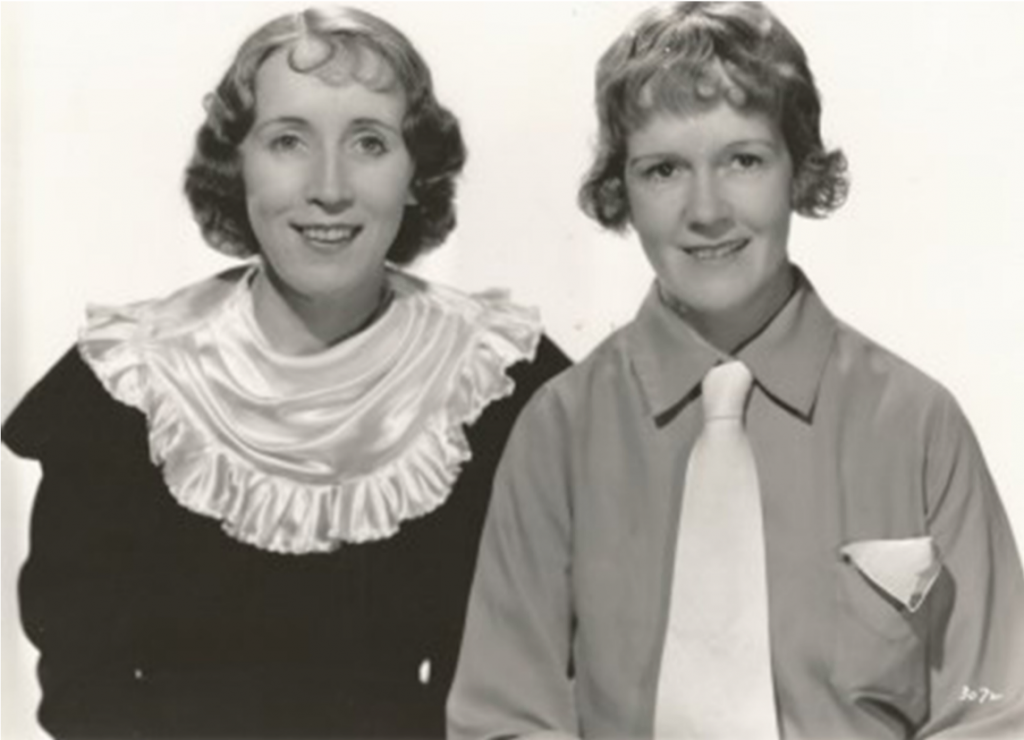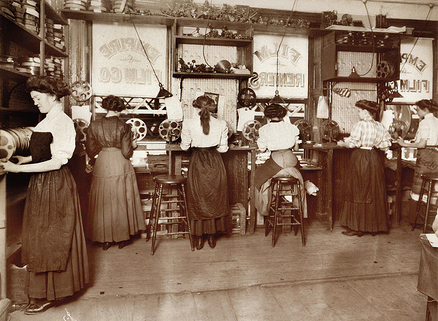Cut to:
The Wizards of The Wizard of Oz

Margaret Booth was the supervising editor at MGM for thirty seven years, and Blanche Sewell was the editor of MGM’s film The Wizard of Oz.

Margaret Booth was the supervising editor at MGM for thirty seven years, and Blanche Sewell was the editor of MGM’s film The Wizard of Oz.
The first films were single shots, but gradually directors like Alice Guy Blaché and Edwin Porter began to develop the art of intercutting shots to create stories.
 The workers who handled the film were called “cutters.” These were mostly women. (“She’s so good at sewing and knitting.”)
The workers who handled the film were called “cutters.” These were mostly women. (“She’s so good at sewing and knitting.”)
As the industry solidified, women were pushed out of the director’s chair and torn away from operating the cameras and lights. But they held onto their editing benches.

With the advent of sound in the late 1920’s there was a new effort to push women out of the editing room. (“Cutting sound is so hard. Let’s get the men to do it.”)
In fact, many of the first sound films were edited by women: by Blanche Sewell at MGM, Viola Lawrence at Goldwyn, Jane Loring at Paramount, and Barbara McLean, who edited Mary Pickford’s first sound film, Coquette (which was produced by Pickford through Pickfair Productions, the company she founded in 1919. Pickford also founded United Artists, with Douglas Fairbanks, Charlie Chaplin and D.W. Griffith.)
 Women held on to the one place in the industry where they could thrive and develop the complex editing techniques that have advanced film to the point at which it is today.
Women held on to the one place in the industry where they could thrive and develop the complex editing techniques that have advanced film to the point at which it is today.
A few of these editors are well known (Dede Allen, Thelma Schoonmaker, Anne V. Coates) while most aren’t known or have been forgotten.
One of the reasons they’ve been forgotten is due to the nature of their work. The relative invisibility of editors—whether male or female—in contrast to the attention paid to writers, directors, cinematographers and composers, has been unwarranted and unjust. Editors make an essential contribution to the success or failure of a film. It’s time to stop imagining that “it’s really the director” who does the editing.

Another reason for our ignorance about the women on this website is that work done by women usually isn’t accorded the respect and attention it deserves. And in the case of film editing, the determination of women to continue doing their work was challenged by men.
Here is Anne V. Coates’ report from the frontlines:
“When I first came into the industry in England [in 1947], there were quite a lot of women editors. And then slowly they fell by the wayside…When I left in 1986 [to work in the U.S.A.], I think there was only one other woman doing big features in England. But I was taught, or I must have heard it somewhere, that as it became a more important job, men started to get in on it. While it was just a background job, they let the women do it. But when people realized how interesting and creative editing could be, then the men elbowed the women out of the way and kind of took over.”

This website covers much more than the Golden Age of the Hollywood studio system (and more than just current Hollywood and big budget narrative film productions, and more than just film production in the United States), but one can’t deny the powerful influence of that era on the development of film as we know it today, which makes this comment from a 2017 profile of Barbara McLean worth noting:
“Although in the last few decades, journalists and reference books have claimed that only eight women worked as editors in the studio era, there were a few more than that. As Editors Guild records and studio newsletters reveal, Caroline Ries, Lucille Tanner, Sylvia Reid, Monica Collingwood, Hazel Marshall, Dorothy Spencer, Mary Steward, Florence Leona Lindsay, Margaret Booth, Ida Jaediker, Lora Hays, Virginia Boland, Marjorie Fowler, Verna MacCurran, Iris Rainsberger, Virginia Lively Stone, Laura Jackson, Betty Lane, Lela Wetzel, Evelyn Kennedy, Erma Levin, Jill Vandenburg, Margaret Harfield, Jeanne Rochlin, Dena Levitt, Kay Rose, Eve Newman, Joyce Breeze, Virginia Gardner, Bettie Biery, Marguerite Sokolow, Rosemarie Hickson, Geraldine Lerner, Anna Kanis, Reva Schlesinger, Sally Flint, Beatrice Conetta, Mary Manfra, Alice Kellor, Wanda Rotz, Roma Crowder, Viola Brown, Mili Bonsignori, Angeline Sweeney, Irene Bazzini, Anne Bauchens, Adrienne Fazan, Eda Warren, Jane Loring, Blanche Sewell, Frances Marsh, Judy Barker, Lucille Jelik, Helen e Turner, Viola Lawrence, Kay Fitzgerald, Lela Simone, Irene Morra, Eleanor Morra, and Alma Macrorie were some of McLean’s colleagues. In production meetings, on the set, and alone in the editing room, their decisions helped shaped “Golden Age” Hollywood cinema.
Traditional auteurists, be warned. Your faith in film authorship may rest on insecure ideological footing.”
— “Barbara McLean: Editing, Authorship, and the Equal Right to Be the Best” by J. E. Smyth. The full text can be found in the Appendix.

With the growing awareness about how women have been kept out of most areas of production and post-production in the film industries as well as in the independent film communities all around the globe, things are changing. Very slowly.

In an effort to speed up that change, here are two hundred and six women you can now name, admire and thank when watching many of the canonical films, as well as many other films you know and love.
One final, related note: While working on the website, I was in touch with Karen Pearlman—a filmmaker, editor and scholar who has written numerous articles as well as a book, Cutting Rhythms: Shaping the Film Edit.
She told me about an idea she had.
Whenever a film is cited in an article or book, it’s normally done like this: “The last scene in North by Northwest (Hitchcock, 1959) is notable for…”
Since that ignores the collaborative nature of the medium and is an exaggeration of the role of the director, she decided to always add “et. al” (and others).
Her citations would now read, “The last scene in North by Northwest (Hitchcock, et al., 1959) is notable for…”
That does something to your brain, doesn’t it?
And wouldn’t it be great if other writers adopted that citation style?
In 2020, I did an interview on the Laura Flanders show, and they created a graphic to illustrate it.
